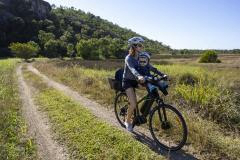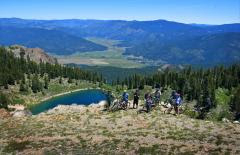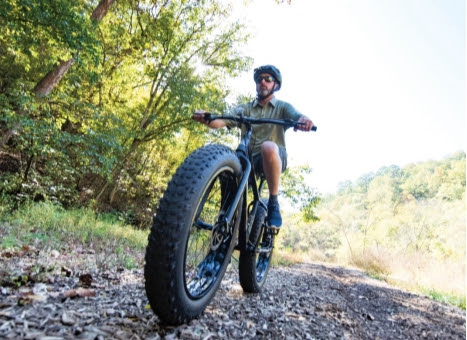By Korey Morgan
Today, the Forest Service recounts their experience with E-bikes that are helping bring more people to their great outdoor spaces.
E-bike sales have surged during the pandemic. Between 2019 and 2020, e-bike sales were up an estimated 145% in the United States. Photo courtesy Sierra Buttes Trail Stewardship with permission.
Joscelyn flashed a wide grin as she rolled back onto the paved parking lot, her cheeks rosy with windburn from the spring air. She pulled the break lever and brought the electric bicycle to a sudden stop in front of the small group of onlookers. “This thing is so awesome!” she said.
The first experience on an e-bike tends to stick with people. They reminisce about how the experience brought back the joy they felt when they first rode a bike as a child.
“It was an instant feeling for me,” said Greg Williams, executive director of Sierra Buttes Trail Stewardship in California. “I thought about all the places I used to ride as a kid when I was super fit and had a lot of time. I got on an e-bike and was like oh man, game on, I’m going to those places again.”
E-bikes use a battery and an electric motor to assist riders while they pedal. The technology makes physically demanding activities like biking up hills or keeping up with a group of friends more realistic for more people.
“Of course, there are many factors involved, but when one takes a friend out for their first ride on a traditional mountain bike, they are either hooked or never want to touch it again. The experience can stretch one’s athletic performance,” said Penny Wu, acting assistant director for recreation at the Forest Service. “E-bikes are different. Some people feel more comfortable on an e-bike, and it gets them coming back again and again.”
The popularity of e-bikes has steadily increased for many years. However, life during the pandemic has supercharged the trend towards the electric motor and two wheels. According to NPD Group Inc, an American market research company, e-bike sales were up 145% from 2019 to 2020. Deloitte predicts 130 million e-bikes will be sold between 2020 and 2023. The economic benefits of e-biking, along with other recreation activities, also extend to local communities.
These days, e-bikes are everywhere.
Like hiking and horseback riding, e-bikes offer another opportunity for people to get out and enjoy their public land. Photo with permission.
“It’s not just traditional bike riders and elders looking to get back into the sport. E-bikes are appealing to a diverse group,” said Williams. “We see young kids, more women, and a range of folks who would not have picked up biking otherwise. Those who might have taken a shuttle to the top of the hill are now hopping on an e-bike and riding right from town.”
It’s no surprise that people are visiting national forests and grasslands looking for opportunities to ride their e-bikes. To better accommodate them, the Forest Service has finalized internal guidance on managing e-bike use on forests and grasslands. The updates help to ensure that e-bike use is done in a socially and ecologically responsible way. They also provide local land managers a clear avenue to expand access.
First, the updated policy is clarifying that over 60,000 miles of motorized trails and thousands of miles of motorized roads are open to e-bikes – more miles of roads and trails than any other federal land management agency.
The agency has also incorporated the widely used 3-tier classification for e-bikes to ensure consistency with other land management agencies and to make policies easier to understand.
The updated guidance lays out the necessary steps before opening a trail to e-bike use: local Forest Service land managers will analyze the potential effects on the environment and examine trails to ensure e-bikers and other users can recreate safely. Decision-makers will engage the community and get input from the public.
“Our policy allows local decisions specific to every forest and every trail. It ensures we’re providing recreation opportunities while balancing our multiple-use mandate and protecting resources for future generations,” said Garrett Villanueva, acting national travel management program manager at the Forest Service.
E-biking can lower the high physical hurdle of climbing hills or long rides. Their pedal assisting technology makes riding with a group of friends or carrying a passenger more realistic for more people. Photo courtesy Sierra Buttes Trail Stewardship with permission.
Everyone, including traditional bikers, hikers, and motorists stand to benefit from a more diverse group of users enjoying public land.
“E-bikes are creating a whole new group of land stewards. It’s getting people out into the forests and caring deeply about their public land, which is a good thing,” said Williams.
“I’m very positive about more people enjoying forests in a responsible way and valuing their public land,” said Wu. “Going forward it’s going to take education, building relationships between users, and reinvesting in land management so that we can meet the needs of a new public utilizing the landscape.”
Learn more about the Forest Service’s e-bike policy. Find out ways to help maintain trails or participate in volunteer work on your local national forest or grassland. The Forest Service also works with nonprofits organizations, such as the International Mountain Bike Association, that provide teams of volunteers.
–
Editor’s Note: We’ve talked for months about how the pandemic and other uncertainties have led many people to rediscover the great outdoors. Today, the Forest Service recounts their experience with E-bikes that are helping bring more people to their great outdoor spaces.

E-bike sales have surged during the pandemic. Between 2019 and 2020, e-bike sales were up an estimated 145% in the United States. Photo courtesy Sierra Buttes Trail Stewardship with permission.
|
Joscelyn flashed a wide grin as she rolled back onto the paved parking lot, her cheeks rosy with windburn from the spring air. She pulled the break lever and brought the electric bicycle to a sudden stop in front of the small group of onlookers. “This thing is so awesome!” she said.
The first experience on an e-bike tends to stick with people. They reminisce about how the experience brought back the joy they felt when they first rode a bike as a child.
“It was an instant feeling for me,” said Greg Williams, executive director of Sierra Buttes Trail Stewardship in California. “I thought about all the places I used to ride as a kid when I was super fit and had a lot of time. I got on an e-bike and was like oh man, game on, I’m going to those places again.”
E-bikes use a battery and an electric motor to assist riders while they pedal. The technology makes physically demanding activities like biking up hills or keeping up with a group of friends more realistic for more people.
“Of course, there are many factors involved, but when one takes a friend out for their first ride on a traditional mountain bike, they are either hooked or never want to touch it again. The experience can stretch one’s athletic performance,” said Penny Wu, acting assistant director for recreation at the Forest Service. “E-bikes are different. Some people feel more comfortable on an e-bike, and it gets them coming back again and again.”
The popularity of e-bikes has steadily increased for many years. However, life during the pandemic has supercharged the trend towards the electric motor and two wheels. According to NPD Group Inc, an American market research company, e-bike sales were up 145% from 2019 to 2020. Deloitte predicts 130 million e-bikes will be sold between 2020 and 2023. The economic benefits of e-biking, along with other recreation activities, also extend to local communities.
These days, e-bikes are everywhere.

Like hiking and horseback riding, e-bikes offer another opportunity for people to get out and enjoy their public land. Photo with permission.
|
“It’s not just traditional bike riders and elders looking to get back into the sport. E-bikes are appealing to a diverse group,” said Williams. “We see young kids, more women, and a range of folks who would not have picked up biking otherwise. Those who might have taken a shuttle to the top of the hill are now hopping on an e-bike and riding right from town.”
It’s no surprise that people are visiting national forests and grasslands looking for opportunities to ride their e-bikes. To better accommodate them, the Forest Service has finalized internal guidance on managing e-bike use on forests and grasslands. The updates help to ensure that e-bike use is done in a socially and ecologically responsible way. They also provide local land managers a clear avenue to expand access.
First, the updated policy is clarifying that over 60,000 miles of motorized trails and thousands of miles of motorized roads are open to e-bikes – more miles of roads and trails than any other federal land management agency.
The agency has also incorporated the widely used 3-tier classification for e-bikes to ensure consistency with other land management agencies and to make policies easier to understand.
The updated guidance lays out the necessary steps before opening a trail to e-bike use: local Forest Service land managers will analyze the potential effects on the environment and examine trails to ensure e-bikers and other users can recreate safely. Decision-makers will engage the community and get input from the public.
“Our policy allows local decisions specific to every forest and every trail. It ensures we’re providing recreation opportunities while balancing our multiple-use mandate and protecting resources for future generations,” said Garrett Villanueva, acting national travel management program manager at the Forest Service.

E-biking can lower the high physical hurdle of climbing hills or long rides. Their pedal assisting technology makes riding with a group of friends or carrying a passenger more realistic for more people. Photo courtesy Sierra Buttes Trail Stewardship with permission.
|
Everyone, including traditional bikers, hikers, and motorists stand to benefit from a more diverse group of users enjoying public land.
“E-bikes are creating a whole new group of land stewards. It’s getting people out into the forests and caring deeply about their public land, which is a good thing,” said Williams.
“I’m very positive about more people enjoying forests in a responsible way and valuing their public land,” said Wu. “Going forward it’s going to take education, building relationships between users, and reinvesting in land management so that we can meet the needs of a new public utilizing the landscape.”
Learn more about the Forest Service’s e-bike policy. Find out ways to help maintain trails or participate in volunteer work on your local national forest or grassland. The Forest Service also works with nonprofits organizations, such as the International Mountain Bike Association, that provide teams of volunteers.
– Korey Morgan
|
|











